

![]()
![]()
This Page:
Elizabeth Forbes
Maude Goodman
Mary L. Gow
Marchioness of Granby
Alice Grant
Kate Greenaway
Blanche Jenkins
Louise Goode Jopling
![]()
![]()

Self-portrait of an Artist--representative work.
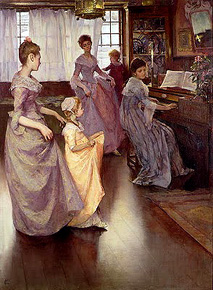
The Minuet 1892--
representative work.
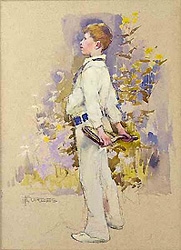
Alec in Whites--
representative work.
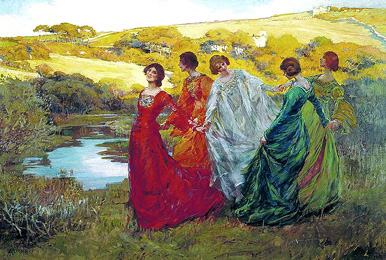
One Fine Day--representative work.
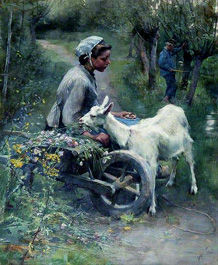
Jean, Jeanne and Jeannette
1892--representative work.

Boy with a Hoe--
representative work.
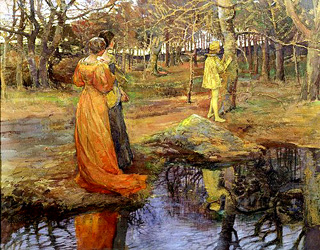
Medieval Woodland Scene--representative work.

The Enchanted Wood--
representative work.
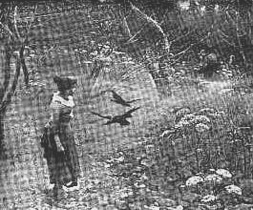
The Witch--exhibited in
Fine Arts Palace,1893 Exposition.
Elizabeth Forbes was born in Canada and encouraged by her father, a government official, in her artistic interests. Accompanied by her mother, she studied art in England, New York (Art Student's League), and Germany. Dissatisfied with the way women art students were treated, she joined other plein air painters in Port-Avon, Brittany where she was soon exhibiting and selling her paintings on peasant themes. In 1855 she met her future husband Stanhope Forbes at his art colony in Newlyn, Cornwall. After their marriage, they opened the Newlyn School of Painting in 1899.
![]()

And They Lived Happily Ever After 1894--
representative work.
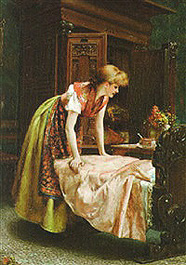
My Dear! 1889--
representative work.

The Little Flowergirl--
representative work.
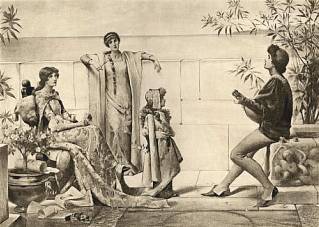
The Awakening--exhibited in the
Fine Arts Palace, 1893 Exposition.
Born in Manchester, Maude Goodman lost her mother shortly after birth and was raised by a supportive step-mother but her father discouraged her artistic ambitions. Eventually she was allowed to attend the South Kensington Schools where she received some art instruction from Edward J. Poynter. After her marriage to Arthur Scanes, she became quite successful painting sentimental pictures of mothers and children.
![]()

Your Majesty--
representative work.
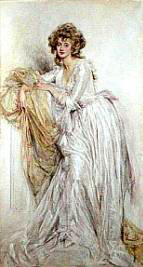
An Edwardian Lady--
representative work.
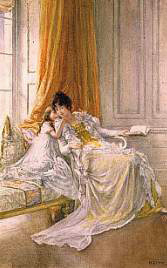
Mother
and Child 1894--
representative work.
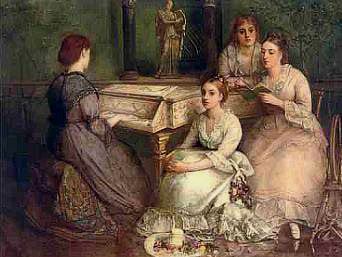
Harmony--representative work.
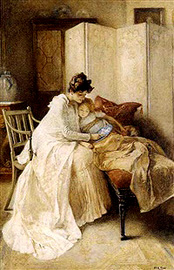
The Story of the Willow
Pattern 1886--exhibited
in the Fine Arts Palace,
1893 Exposition.

Fairy
Tales--
representative work.
Beggar My Neighbor (image unavailable)--
exhibited in Fine Arts Palace,
1893 Exposition.
Mary L. Gow and her artist brother (Andrew) were the children of genre-historical painter James Gow. She received her training at Queen’s Square School of Art and the Heatherley School of Fine Art and often exhibited at the Royal Society of British Artists, the Royal Academy, and the Royal Institute of Painters in Water-Colours, but later became known for her children's books illustrations. Mary and her brother were associated with the Lawrence Alma-Tadema circle of artists. She married painter-illustrator Sydney Prior Hall.
![]()
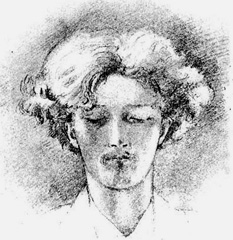
Paderewski--representative work.

Lady
Susan Kepel--
exhibited in the Fine Arts
Palace, 1893 Exposition.
Born a noblewoman (her father was the son of an earl and her mother a daughter of a dean), the British artist Marion Margaret Violet Lindsay (later Marchioness of Granby--or Violet Granby, as she signed some of her work) had no formal training in art, but she was closely associated as an adult with "The Souls," an avant-garde circle of aristocrats during the 1870s-90s committed to an aesthetic way of life. She was known for her unconventional flowing robes of faded colors in the style of the aesthetes. She published a selection of her portraits in 1900 in "Portraits of Men and Women" and exhibited her whole life in all the major British galleries and in France and the United States. She married Henry John Brinsley Manners who became Marquess of Granby and later Duke of Rutland.
![]()
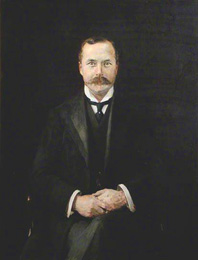
Peter Freyer, KCB
--
representative work.

Old Man with Beard
--representative work.
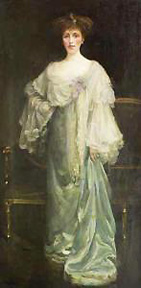
Elegant Lady 1906--
representative work.
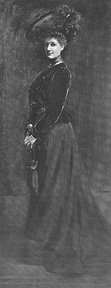
Portrait
of
Mrs. H. A. Grant--
representive work.
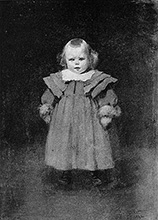
Portrait of a Child--
exhibited in Rotunda, Woman's
Building, 1893 Exposition.
Alice Grant studied art at Mr. Dowling's Studio in London. She was a member of the Ridley Art Club and had several portraits exhibited at the Royal Academy. No further information is available online.
![]()
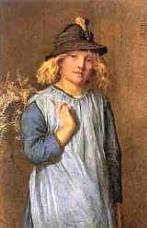
The Fern
Gatherer--
representative work.
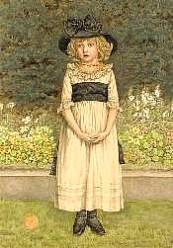
Portrait
of a Young Girl--
representative work.
Title-page, Little Phyllis, and My little Girlie in Marigold Gardens
Mulberry Bush in Children's Games;
Game Play in Language of the Flowers;
Girl Drawing Chaise with Two Children (images unavailable)
--6 illustrations exhibited in Fine Arts Palace, 1893 Exposition.
The daughter of a well-known wood-engraver, Kate Greenaway was born in London and studied art at a South Kensington School and at the Slade School. In 1868 she began her highly successful career as a commercial artist designing holiday cards and illustrating children's books. The Regency-style costumes she created for those books eventually set a fashion in children's clothes. The Kate Greenaway Medal, established in her honor in 1956 by the British Library Association, is awarded annually to distinguished illustrators of children's books in the United Kingdom.
![]()
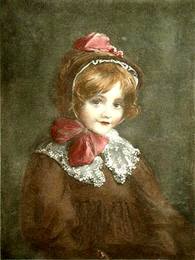
Little Elsie--
representative work.
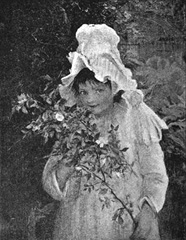
In the Month of Roses--
representative work.
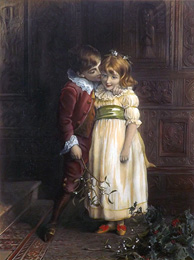
My First Kiss--representative work.
Water Nymph (image unavailable)--exhibited
in Fine Arts Palace, 1893 Exposition.
A Sunbeam in the Shade (image unavailable)--
exhibited in the Rotunda, Woman's Building,
1893 Exposition.
Blanche Jenkins was a British artist who studied at the British Royal Academy in the early 1870s. Children's portraits seem to have been her main subject. No other information is available online.
![]()

Self-portrait 1877--representative work.

A Modern Cinderella 1875--
representative work.

Portrait of George Bernard
Shaw as a Young Man
--representative work.
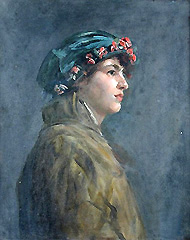
Portrait of a Scottish Girl
--representative work.

Portrait of a Girl
Holding a Bouquet
--representative work.
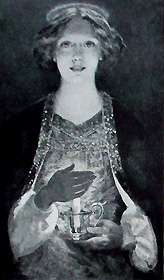
Bonnie St. Bride [Brigit]
--representative work.

Salome Carrying the Head
of John the Baptist to her
Mother--exhibited in the Fine
Arts Palace, 1893 Exposition.

Dear Lady Disdain
[private collection, Washington, D.C.]
--exhibited in Fine Arts
Palace, 1893 Exposition.
An English Maiden (image unavailable)--
exhibited in the Rotunda, Woman's Building,
1893 Exposition.
Louise Jopling was born in Manchester, married at 17, and studied art with Charles Chaplin and Alfred Stevens in Paris. Widowed, she married artist Joseph Jopling. She exhibited at Grosvenor Gallery and was the first woman to be elected a member of the Royal Society of British Artists. Jopling also campaigned successfully for equal rights for women members of the Society of Portrait Painters. In 1887 Jopling set up a School of Painting to train professional women artists. Widowed again, she married George Rowe. Her autobiography was published as Twenty Years of My Life.
Samuel Smiles 1856--portrait.
![]()
![]()
Go to British Women Painters, p. 3
Return to Women Painters Index
Return to Site Index
![]()
![]()
Text written by K. L. Nichols
Painting, top of page: Marie Konstantinovna
Bashkirtseff,
In the Studio (1881).
Return to Nichols Home Page
Suggestions/Comments: knichols11@cox.net
Posted: 6-25-02; Updated: 5-16-20